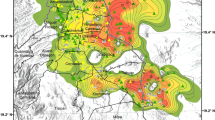Abstract
High-resolution space-borne remote sensing data are investigated for their potential to extract relevant parameters for a vulnerability analysis of buildings in European countries. For an evaluation of large earthquake scenarios, the number of parameters in models for vulnerability is reduced to a minimum of relevant information such as the type of building (age, material, number of storeys) and the geological and spatial context. Building-related parameters can be derived from remote sensing data either directly (e.g. height) or indirectly based on the recognition of the urban structure type in which the buildings are located. With the potential of a fully- or semi-automatic inventory of the buildings and their parameters, high-resolution satellite data and techniques for their processing are a useful supporting tool for the assessment of vulnerability.
Similar content being viewed by others
References
InstitutionalAuthorNameATC-13 (1985) Applied Technology Council, Earthquake Damage Evaluation Data for California ATC-13 Redwood City, California
E. P. Baltsavias A. Gruen L. Gool ParticleVan (Eds) (2001) Automatic Extraction of Man-made Objects from Aerial and Space Images (III) Ashgate Pub Co. Aldershot, UK
Eguchi, R. T., Houshmand, B., Huyck, C. K., Mansouri, B., Matsuoka, M., Shinozuka, M., Yamazaki, F., and Ulgen, S.: 2000, Using advanced technologies to conduct earthquake reconnaissance after the 1999 Marmara earthquake, In: Proc. 2nd Workshop on Advanced Technologies in Urban Earthquake Disaster Mitigation, DPRI, Kyoto University, Uji, Kyoto, Japan, available at: imagecatinc.com/reportspubs/mamarappr.pdf (accessed February 2004)
C. S. Fraser E. Baltsavias A. Gruen (2002) ArticleTitleProcessing of IKONOS imagery for submetre 3D positioning and building extraction ISPRS J. Phot. Remote Sens. 56 177–194
Gerke M., Heipke C., and Straub B.-M.: 2001, Building extraction from aerial imagery using a generic scene model and invariant geometric moments, In: Proc. IEEE/ISPRS Joint Workshop on Remote Sensing and Data Fusion over Urban Areas, Rome, Italy, 85–89
S. Goebell H.-U. Wetzel (2006) ArticleTitleContributions to the Deformation Analysis in Germany Based on Precise and Continuous GPS Measurements Nat. Hazards 38 177–197
G. Grünthal (Eds) (1998) European Macroseismic Scale 1998 Cahiers du Centre Européen de Géodynamic et de Séismologie Luxembourg
HAZUS: 1999, National Institute of Building Science (NIBS) – Earthquake Loss Estimation Methodology, Hazus®99 Technical Manual, Report prepared for the Federal Emergency Management Agency, Washington, DC., available at: http://www.fema.gov/hazus/dl_sr2.shtm (accessed February 2004)
IKONOS: 1999: Product guide and technical information, available at http://www.spaceimaging.com/products/ikonos/ (accessed February 2004)
R. B. Irvin D. M. McKeown SuffixJr. (1989) ArticleTitleMethods for exploiting the relationship between buildings and their shadows in aerial imagery IEEE Trans. Syst. Man Cyber. 19 IssueID6 1564–1575
J. R. Jensen C. Cowen (1999) ArticleTitleRemote sensing of urban/suburban infrastructure and socio-economic attributes Phot. Eng. Remote Sens. 65 IssueID5 611–622
K. Kraus (1993) Photogrammetry. Vol.1: Fundamentals and Standard Processes EditionNumberFourth Edition Dümmler Verlag Bonn, Germany
Lang, K.: 2002, Seismic vulnerability of existing buildings, PhD thesis. Institut für Baustatik und Konstruktion, ETH Zürich, IBK-Report, No. 273, Feb. 2002, available at: http://www.ibk.baug.ethz.ch/emeriti/Bachmann/publ/LA02.html (accessed February 2004)
Mayer, S.: 2001, Constrained optimization of building contours from high-resolution ortho-images, In: Proc. IEEE Signal Processing Society – 2001 International Conference on Image Processing (ICIP 2001), Oct. 7–10, Thessaloniki, Greece, available at http://solarsystem.dlr.de/FE/abteilung/pdfs/sm-icip2001.pdf (accessed February 2004)
Mueller, M. and Segl, K.: 2001, House detection in IKONOS data using region and edge based segmentation, In: Proc. SPIE’s International Symposium on Optical Science and Technology – Application of Digital Image Processing XXIV, San Diego, USA, 4472, pp. 500–507
Mueller, M. and Segl, K.: 2002, Fuzzy information fusion for the extraction of urban features based on HRSC data, In: Proc. SPIE’s 9th International Symposium on Remote Sensing – Image and Signal Processing for Remote Sensing VIII, Crete, Greece, 4885, pp. 152–161
M. Mueller K. Segl H. Kaufmann (2003) ArticleTitleExtracting characteristic segments in high-resolution panchromatic imagery as basic information for object-driven image analysis Can. J. Remote Sens. 29 IssueID4 453–457
MunichRe: 2002, Munich Re Group - Annual Report 2001, available at http://www.munichre.com/pdf/gb_2001_e.pdf (accessed February 2004)
QuickBird: 2001, QuickBird imagery product guide, available at http://www.digitalglobe.com/products/product_docs.shtml (accessed February 2004)
RADIUS: 2000, Risk Assessment Tools for Diagnosis of Urban Areas Against Seismic Disasters, information available at http://geohaz.org/radius (accessed February 2004)
S. Roessner K. Segl U. Heiden H. Kaufmann (2001) ArticleTitleAutomated differentiation of urban surfaces based on airborne hyperspectral imagery IEEE Trans. Geosci. Remote Sens. 39 IssueID7 1525–1532
Roessner, S., Wetzel, H. -U., Kaufmann, H., and Sarnagoev, A.: 2002, Satellite remote sensing for regional assessment of landslide hazard in Kyrgyzstan (Central Asia), In: Proc. Zweites Symposium Katastrophenvorsorge, DKKV, Leipzig, Germany, Sept. 24–25, 2001, pp. 433–441
F. F Sabins (1997) Remote Sensing: Principles and Interpretation EditionNumberThird Edition, W.H. Freeman & Co. New York, NY
D. Scharstein R. Szeliski (2002) ArticleTitleA taxonomy and evaluation of dense two-frame stereo correspondence algorithms Int. J. Comp. Vis. 47 IssueID1–3 7–42
Smith, G.M. and Hoffmann, A.: 2001, An object based approach to urban feature mapping, In: C. Jürgens (ed.), Remote Sensing of Urban Areas/Fernerkundung in Urbanen Räumen, Regensburger Geographische Schriften, band 35, pp. 100–106
Toutin, Th., Chénier, R., and Carbonneau, Y.: 2002, 3D models for high resolution images: examples with QuickBird, IKONOS and EROS, In: Int. Archives of ISPRS Symposium, Comm. IV, Ottawa, Ontario, Canada, July 8–12, 2002, vol. 43, part 4, pp. 547–551
Twigg, J. (ed): 1998, Development at Risk? Natural Disasters and the Third World, The UK National Co-ordination Committee for the International Decade for Natural Disaster Reduction (IDNDR), Neil Terry Printing, available at http://www.oneworld.org/idndr/ (accessed February 2004)
R. Wittig H. Sukopp B. Klausnitzer A. Brande (1998) Die ökologische Gliederung der Stadt H. Sukopp R. Wittig (Eds) Stadtökologie EditionNumber2 Gustav Fischer Verlag Stuttgart 316–372
Yamazaki, F.: 2001, Applications of remote sensing and GIS for damage assessment, In: ICUS/INCEDE Report 1, Joint Workshop on Urban Safety Engineering, Bangkok, pp. 69–84, available at: http://icus.iis.u-tokyo.ac.jp/wwwe/publications/reports/report1- content.htm (accessed February 2004)
Author information
Authors and Affiliations
Corresponding author
Rights and permissions
About this article
Cite this article
Mueller, M., Segl, K., Heiden, U. et al. Potential of High-Resolution Satellite Data in the Context of Vulnerability of Buildings. Nat Hazards 38, 247–258 (2006). https://doi.org/10.1007/s11069-005-8637-x
Received:
Accepted:
Issue Date:
DOI: https://doi.org/10.1007/s11069-005-8637-x




